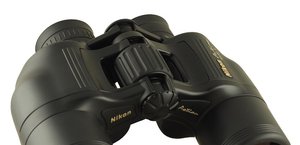Leica Ultravid HD-Plus 10x42
Compared to the previous version the producer used Schott HT glass with a higher transmission level.
The magnesium body of the binoculars is covered by soft matt rubber which ensures a firm, comfortable grip in every conditions. Additionally the instrument is waterproof up to 5 meters and nitrogen-filled. The Ultravid HD-Plus binoculars can be used in temperatures ranging from –25 to +60░C.
Buyers get a neoprene strap, a Cordura case and caps for objectives and eyepieces as a part of the accessory kit. Every instrument comes with a 10-year guarantee.
| Magnification | Lens diameter | Angular field of view | Prisms | Eye relief | Weight | Price |
|---|---|---|---|---|---|---|
| 10 | 42 | 112/1000(6.4o) | BaK-4/roof | 16 mm | 750 g | 6950 PLN |
Summary
Pros:
- exceptionally solid and stylish casing, comfortable to hold,
- good transmission,
- excellent astigmatism correction,
- slight coma,
- low chromatic aberration in the field centre,
- very good distortion correction,
- negligible brightness loss on the edge of the field,
- high quality prisms and coatings,
- excellent blackening inside the tubes,
- good whiteness rendering.
Cons:
- a bit too high level of chromatic aberration near the edge of the field of view.
 |
The history of contemporary 42 mm Leica binoculars began in 1990 - during the Photokina fairs that German company presented three Trinovid BA models. After ten years the successors of that series, called Trinovid BN, were shown. The main change consisted of shortening the minimum focusing distance, that’s why the N letter appeared in the name (English ‘near’). It is possible that the antireflection coatings were improved as well.
In 2003 the company’s line-up was complemented by Ultravid BR models. I use the term ‘complemented’ deliberately – the Ultravids were marketed as optical equivalents of the Trinovids but their optics was supposed to be closed into a physically lighter casing. They were also offered at the same time as the Trinovids.
Two things happened in 2007: the production of Trinovids ceased and the Ultravids HD were launched on the market. Once again the new pairs of binoculars differed from the old ones in their casing (which weight was reduced for the second time); apart from that the field of view increased slightly and the producer added AquaDura hydrophobic coatings along with improved antireflection coatings.
Year 2014 saw another Leica launch, this time of the Ultravid HD-Plus series. Still, if you compare these devices to the Ultravid HD binoculars you find out all the numbers remained the same. The producer just boasted of using glass of new type produced by the Schott company, with a better transmission.
Why am I writing about it? On our website you can find tests of all 10x42 models, from the Trinovid BN to the Ultravid HD-Plus. It is easy to check what the customers gained throughout all these years. Firstly the results show unanimously that, within the margin of measurement error, the HD-Plus model is practically the same as the HD model. Maybe the transmission level varies a bit but even if you compare the measurements taken with a spectrophotometer the differences remain very slight; it is really difficult to say whether they are an effect of measurement errors, natural differences between two specimens or the actual influence of Schott HT glass. If the spectrophotometer doesn’t show any distinct difference, it won’t be visible to the naked eye either.

So we have a situation where the Ultravid HD doesn’t differ markedly from the Ultravid BR and the Ultravid BR is an almost identical copy of the Trinovid but closed in a lighter casing. It seems that for almost 25 years Leica haven’t introduced any innovative optical solutions to its key series of binoculars. Of course the weight reduction and hydrophobic coatings are appreciated, along with a slight transmission increase or a tad wider field of view. Still such a reputable company should have done better, especially if you take into account the length of the period of time we are talking about. As a result of such stagnation Leica devices started to compete with each other: you can still buy second-hand specimen of Trinovids in mint condition for half the price of the new Ultravids HD-Plus.
That tactics of Leica is especially strange because generally you can’t deny the company an innovative approach in optics, particularly when it comes to binoculars. After all they pioneered in the rangefinder optics, making such revolutionary moves as launching Perger-Porro prisms instruments on the market. Why the line-up of ordinary binoculars has seen so few ground-breaking changes we don’t know.
It would be good to finish our test on a more positive note so it should be emphasized that in the premium class of binoculars, apart from very good optics, the Leica also competes successfully with others when it comes to physical dimensions as it can be seen in the photo below, where it is positioned next to the Zeiss Victory HT 10x42.
On the other hand in this class of equipment you can find other renowned producers beside Leica which are able to construct good, small pairs of binoculars – please consult another photo with the tested Leica positioned next to the Swarovski SLC 10x42 W B.
To sum up the Leica Ultravid 10x42 HD-Plus is a very good set of binoculars - almost exactly as good as its direct predecessors and the predecessors of its predecessors too. We hope the next model of this series will be truly different, not a merely refreshed version of the same device with just a few cosmetic changes.


















